Moving homes, and detaching yourself from an established 'matrix of safety' can be a stressful undertaking, and not a task that anyone relishes.
But for businesses, the challenge of moving massive volumes of data and computing resources from on-premise data centers to a new cloud environment run by cloud providers can be even more overwhelming.
Rapidly maturing cloud computing technology has encouraged many organizations to investigate cloud services as an alternative to capital-draining privately housed IT infrastructure.
Today, cloud migration is no longer a buzzword, or a 'good-to-have', but has become more of a statement of inevitability. Organizations are in search of better scalability, increased agility, cost savings and more efficiency. With the implementation of remote and hybrid working models in today's workplace, cloud migration is a no-brainer.
According to research by Gartner the spend on public cloud services to grew from $410.9 billion in 2021 to $494.7 billion in 2022, representing an increase of 20.4% , with end-user spending expected to reach about $600 billion by the end of 2023.
Cloud environments are fast becoming the new destination for business operations, and the cloud journey is one that more and more businesses have already embarked on.
In this guide, we'll explain how to tackle the most important aspects of the cloud migration process, and try to make the thought of your move to the cloud a little less stressful.
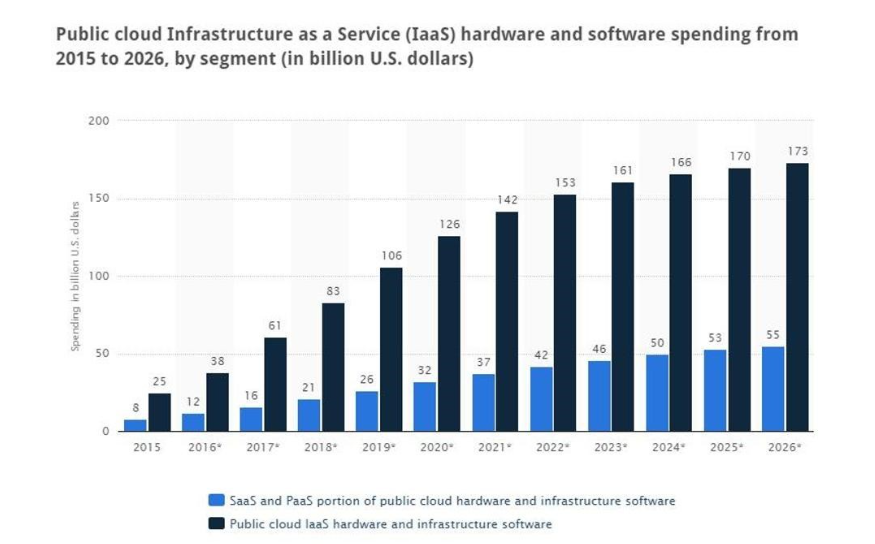
Image source: Insight
What is cloud migration?
Cloud migration involves moving computing workloads to a cloud computing environment. This includes existing applications and databases running in on-premises or co-located infrastructures
Your cloud migration strategy can be carried out in a number of ways, depending on what your business is hoping to achieve. For example, your cloud migration process could be a partial move of digital assets, or a comprehensive complete move - or even shifting cloud platforms from, one to the other.
There are a number of considerations for businesses as to where their cloud workloads should be; whether they should choose a public cloud service, private cloud or hybrid cloud platforms. There are arguments for and against each cloud model, but a successful migration depends on well-thought-out strategies and careful cloud migration planning.
Your cloud migration could involve re-locating thousands - or even tens of thousands of databases, critical applications, and DevOps tools and services.
Find out more about transitioning your unified communications infrastructure to the cloud
Read our blog
Cloud migrations, for any organization are all about improving operations, increasing scalability, saving costs, creating more elastic workplaces, and being at the forefront when new tech innovations become available.
Some of the world’s most popular cloud-computing services include:

Image source: ModLogix
A successful cloud migration project will empower businesses by alleviating the need to hire dedicated staff to perform repetitive work such as overseeing and replacing hardware, on premises databases, and constantly updating software and applications.
Cloud migration, when it all goes smoothly, can alleviate the repetitive and tedious tasks involved with running a business, allowing teams to get on with the real job of building success.
But not all business workloads actually benefit from a cloud-based infrastructure, so it's crucial when planning your migration strategy, to prioritize which elements of your digital assets should move first.
What are the benefits of migrating to the cloud?
Cloud migration, or moving from predominantly on-premises infrastructure to the cloud can be a potentially transformative leap into digital space. There are many advantages to relocating your business to a cloud environment, from saving costs to opening up new and innovative opportunities for business growth. Here are 8 of what we think are the top benefits of cloud migration:

Image source: Spiceworks
1. Scalability and flexibility
Undoubtedly, one of the most significant benefits of cloud migration is the opportunity for businesses to upscale resources when they need to, and downscale them when they don't. Cloud providers enable organizations to take advantage of services including storage and increased computing power so that they can easily handle fluctuating workloads and shifts in traffic. This translates to better efficiency, optimized utilization of resources and reduced costs.
2. Enhanced collaboration
Cloud migration creates an environment that enhances communication and collaboration by facilitating seamless access to data, services and applications from any location, by anyone authorized to do so. This supports today's distributed workforce models as well as allowing businesses to expand their reach to international markets without creating additional physical infrastructure.
3. Cost efficiency
Cloud migration alleviates the dependence on the upfront capital expenditure (CapEx) needed to invest in physical hardware and infrastructure. Instead, cloud services provide an operational expenditure approach (OpEx), allowing businesses to pay-as-you-go, which aligns costs with actual usage. This can mean significant cost savings on hardware, maintenance, software licenses and energy.

4. Innovation and speed to market
Switching to a cloud platform can empower organizations to adapt almost immediately to changing market conditions and rapidly shifting customer demands. In a cloud infrastructure, businesses can experiment freely with new applications and resources, allowing innovation and accelerating time-to-market for new initiatives. In dynamic industries, this creates a competitive advantage and fosters business growth.
5. Easier disaster recovery
With most cloud-based solutions, data is stored and backed up across multiple data centers, which creates a built-in disaster recovery mechanism. This reduces the risk of data loss in the case of severe or intermittent outages, hardware failure or natural disasters, and ensures business continuity.
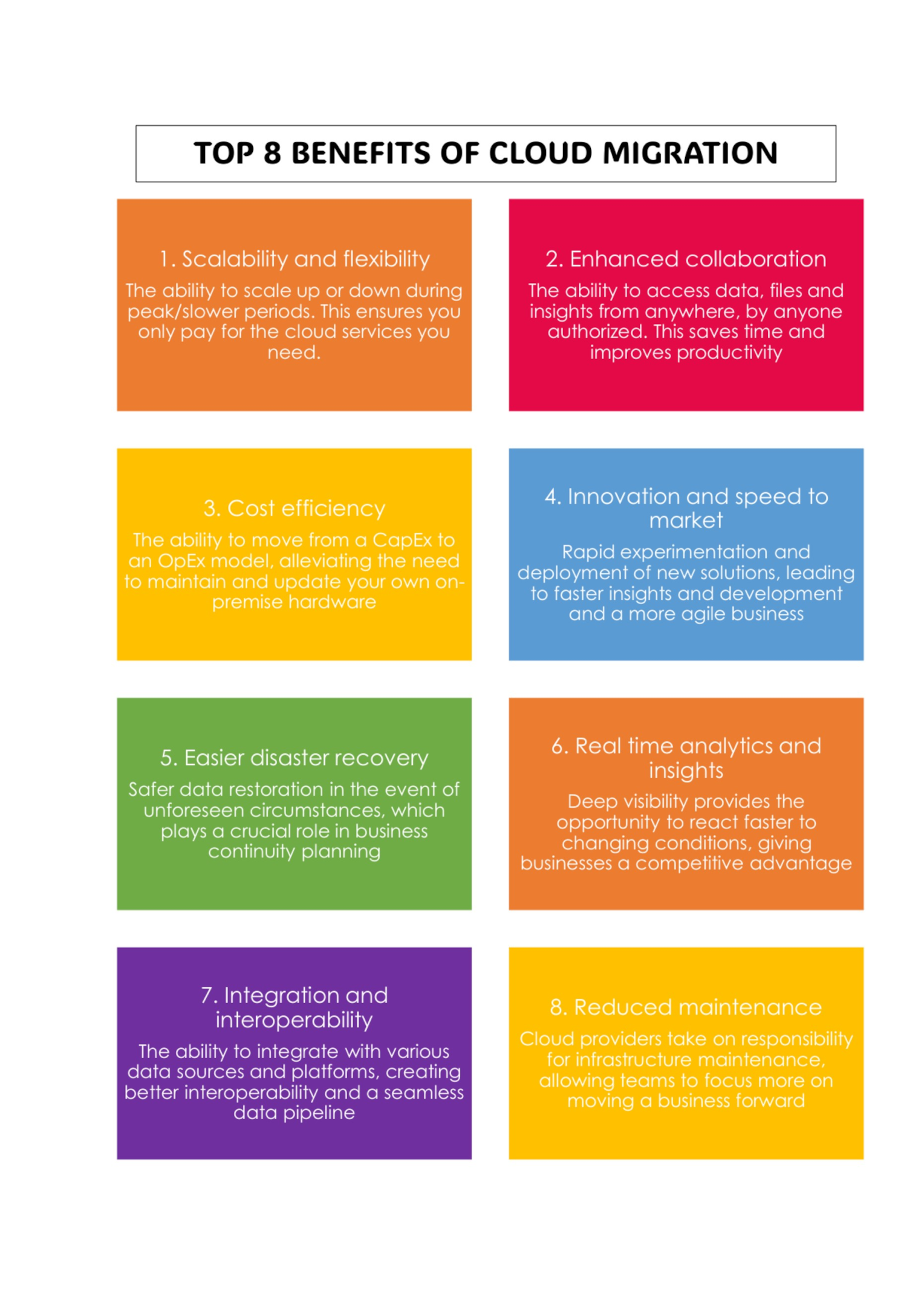
6. Real time analytics and insights
Most businesses have massive volumes of data, but being able to process this data and produce real time analytics from it takes resources, and can be difficult when working with an on-premises data center. This is where cloud-based data analytics can prove invaluable, by making it easy to conduct a more granular analysis of data, as well as being able to share it with others.
7. Integration and interoperability
A cloud infrastructure offers the ability to integrate with a wide variety of data sources and platforms. Data migration to the cloud creates a seamless pipeline and better interoperability.
8. Reduced maintenance and enhanced security
Cloud providers take care of system maintenance, security patches, and make sure that services and applications are operating on the latest available software, as well as monitoring the underlying infrastructure. Automatic updates also reduce the risk of security breaches and enhance performance, enabling organizations to focus on core business activities.
Need tips on mastering your UC migration to the cloud?
Key cloud migration challenges
While we've covered many of the benefits of cloud migration, the process of switching to cloud deployment can be lengthy, complex and risky. It's imperative that organizations have a clear and carefully constructed cloud migration strategy in place before embarking on their move to the cloud to ensure successful cloud adoption.
Additionally, whether migrating workloads and infrastructure to major cloud providers like Google Cloud Amazon Web Services (AWS), VMware Cloud, Microsoft Azure, or leveraging a multi-cloud environment, you'll need to consider what cloud providers offer.

Let's look briefly at some of the cloud migration challenges and risks that many businesses face as they transition resources to the cloud, and ways to reduce risk.
1. Data Security and Compliance Risks
Depending on the integrity of your cloud provider, most cloud services are inherently secure, but data safety an security are up there with the top challenges for businesses planning a cloud migration strategy. Data compromises during the migration process or inefficient access and control over sensitive data can be a major concern.

Image source: Stormit
Overcoming the challenge:
Running your data through a secure route within the firewall during migration and encrypting the data can add an extra layer of assurance and make sure that your strategy follows industry compliance standards.
2. Cost uncertainties
A successful cloud migration can significantly reduce IT operating costs in the long term, but many organizations find that they can encounter hidden cloud costs and expenses such as bandwidth and data transfer costs, training and re-skilling costs and vendor lock-in , during the migration process.
Overcoming the challenge:
Make certain that your cloud providers factor any hidden costs of migration into the budget.
3. Migration Complexities
Underestimating the complexity of the project is another top challenge. For example, transferring legacy software is not always possible, cloud migration tools may not suitable for your migration process, or you may be unsure whether you should adopt a public cloud, private cloud or hybrid cloud model.
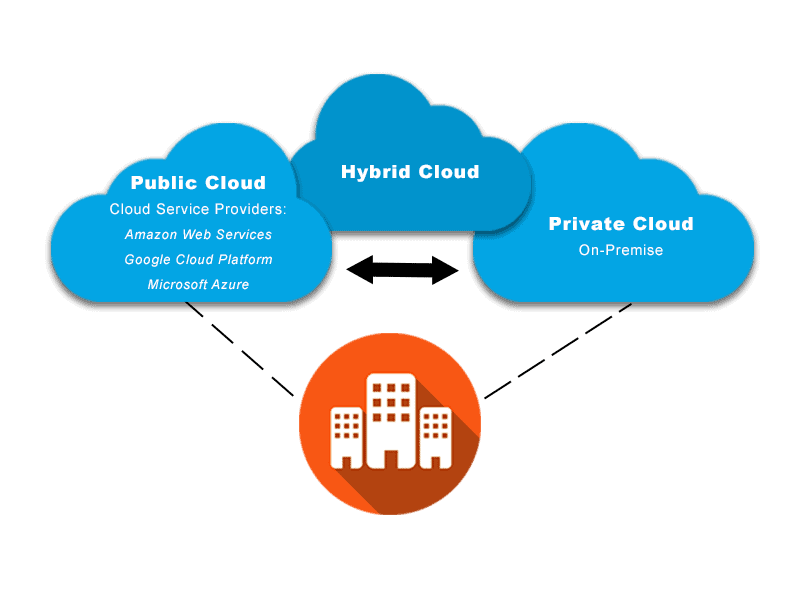
Image source: AVI Networks
Overcoming the challenge:
Spend time properly assessing your current infrastructure to spot compatibility issues or dependencies and choose the right cloud provider who can meet your particular business needs.
4. Incorrectly defining network bandwidth
It's important to define network bandwidth requirements of cloud-powered applications, or risk your migrated applications experiencing latency, which can result in poor user experience and unfulfilled business requirements.
Overcoming the challenge:
Network technology modeling tools will help you evaluate current application performance to reveal areas that need improvement before the migration process.
Types of cloud migration strategies
Every cloud migration journey is different, but in general, there are three main types of cloud migration:
-
On-premises to cloud
-
Cloud to cloud,
-
Cloud to on-premises (reverse cloud migration).
To make the cloud migration process work smoothly and seamlessly, there are useful methods and strategies you can use.
Here we'll cover three of the most important cloud migration types:
Re-host (or 'lift and shift')
This cloud strategy refers to the method of moving data and the rest of an organization's workload into the cloud as-is without any modifications. It involves using your cloud provider's infrastructure-as-a-service (IaaS) technologies. Organizations often consider this strategy as it's relatively simple start to their cloud migration process.
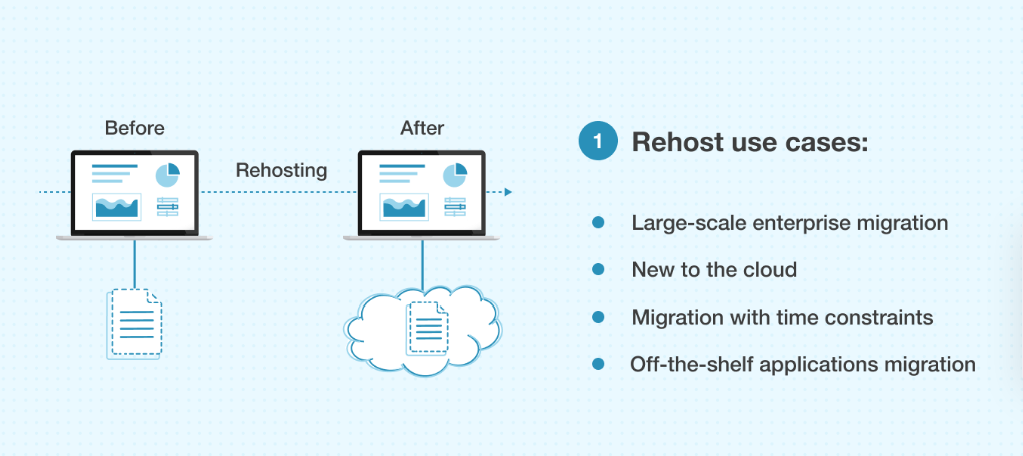
Image source: Simform
Re-factor
To properly realize the benefits and advantages of cloud features and flexibility, re-factoring involves 'app modernization', or updating the application’s existing code. While this is a much more complex and time-consuming strategy requiring source code changes and the introduction of new technologies, it can provide the best return on investment in the long run.
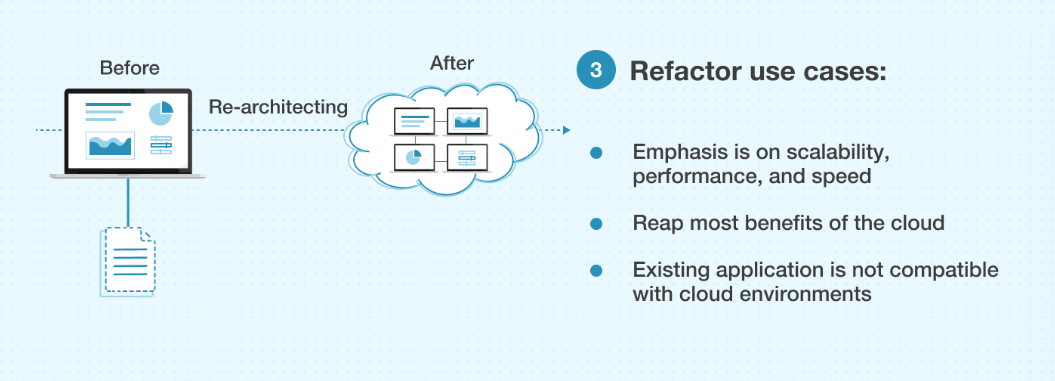
Image source: Simform
Re-platform
Replatforming is a mid-way strategy between refactoring and rehosting, and often involves restructuring the database to a more cloud-native architecture. This could include adding scaling mechanisms, or containerizing applications.
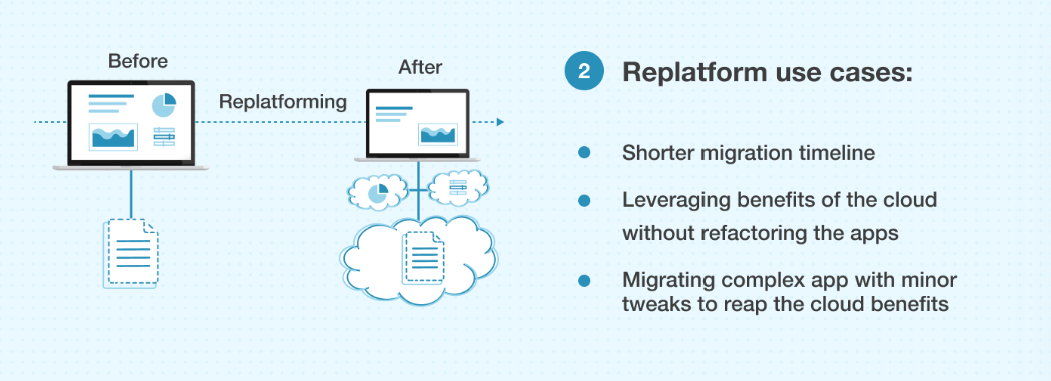
Image source: Simform
What is cloud to cloud migration?
Many organizations already store some or most of their content in one cloud platform. But sometmes they may want to optimize their cloud resources by migrating to a new or multiple cloud platforms, or even dividing their cloud workload into a multi-cloud environment. This is referred to as cloud to cloud migration.
Going through the cloud migration process, and want to know what mistakes to avoid?
Find support for your cloud migration
Monitoring and clear visibility into your entire IT infrastructure is essential for any organization, but this is even more crucial when you begin your cloud transformation.
If your IT environment is multi-faceted, with public and private clouds, on-premises as well as cloud infrastructure, then you need to access controls to your entire ecosystem. Full visibility enables you to unlock even greater potential from your cloud migration.
How IR can help with your cloud migration strategy
Most cloud providers will provide basic security analytics or monitoring throughout their cloud environments, but what if your organizations is using more than one cloud?
IR Collaborate, allows complete control over the performance of your on premises and cloud-based assets by:.
-
Giving you the tools to make better decisions about resources and cost optimization.
-
Capturing the right data and analyzing it properly.
-
Enhancing security and protecting sensitive data through real-time threat monitoring and response.
-
The ability to test voice, video, web, and collaboration components of your ecosystem.
-
Gaining end-to-end, multi-vendor visibility from a single viewpoint.






